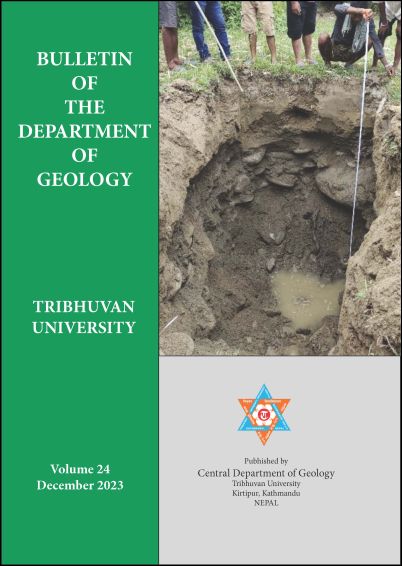Water Management in Hariwan Municipality of Nepal: Groundwater Harvesting from Riverbeds and Aquifers
DOI:
https://doi.org/10.3126/bdg.v24i.68372Keywords:
Shallow aquifer, Dug wells, Sump wells, Lakhandehi RiverAbstract
Most of the regions of the Siwalik and Northern Terai (Bhabar) have a scarcity of water due to the water level beyond the suction limit of ordinary centrifugal pumping. In the present study, the Lakhandehi River section in the Sarlahi district is selected for shallow aquifer prospecting. The objective of this study was to assess potential zones of shallow aquifers including riverbeds. It was also aimed to assess the status of the existing subsurface water conditions, and distribution system, and find out suitable locations for groundwater harvesting and uses. The methodological part of the present study covers the field data collection and finding the appropriate shallow aquifer for groundwater extraction. In the field study, both the geological as well as hydrogeological maps were prepared on a 1:25,000 scale to assess the aquifer condition. A social survey was also carried out to find the most water scarcity areas and water availability conditions in the region. The main water scarcity area is found in the Hariwan Municipality, around the northern part of Bhabar and the southernmost region of the Chure region. The water insufficiency area for the present study was found in the places like Hariyon Khola section (Dumrighari), Sano Dume and Dume Khola sections (Samari Bhanjyang), Kothi Khola section (Kothikholagaun), and Attrauli Khola section (Atrauli village) of Hariwan Municipality due to the presence of impermeable layers in shallow depth. The concept of the development of swamp wells by retaining the groundwater flow from the shallow depth of the river channel is proposed in areas like the Samari Bhanjyang and Atrauli villages. Similarly, the development of shallow wells is proposed for the other two regions. To ensure a cost-effective water supply to the communities, it is advisable to implement a water lifting system to elevate the reservoir, followed by gravity-flow distribution.
Downloads
Downloads
Published
How to Cite
Issue
Section
License
© Central Department of Geology, Tribhuvan University, Nepal

